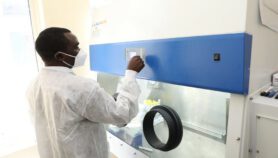By: Syful Islam
Send to a friend
The details you provide on this page will not be used to send unsolicited email, and will not be sold to a 3rd party. See privacy policy.
[DHAKA] Chopped up plastic bottles covered in a common chemical may be a simple and inexpensive method for removing arsenic from drinking water.
A team of chemists at Monmouth University, United States, found that bits of plastic coated with cysteine, a common molecule found in foods, bind to arsenic.
"Laboratory experiments have shown that the method has the potential to be very efficient and very cost effective," Tsanangurayi Tongesayi, lead author of the study and an assistant professor at the university told SciDev.Net.
"The method uses plastics which are cheap and locally available," he added. "[It] is eco-friendly because it involves recycling of plastic bottles [and] is also safe because the chemical ingredients used are not toxic."
In Bangladesh alone some 35 million people are exposed to arsenic contamination from drinking water, according to the Department of Public Health Engineering (DPHE), and estimates say around 100 million in the developing world are affected.
Arsenic has been linked to a variety of health problems from stomach pains and blindness to various cancers — one in five deaths in Bangladesh has been linked to arsenic exposure.
Tongesayi presented his team’s findings last week (31 August) at the annual meeting of the American Chemical Society. The researchers showed that the method can reduce the arsenic content from 20 parts per billion (ppb) — two times higher than the safe standard set by the US Environmental Protection Agency for drinking water — to 0.2 ppb.
Tongesayi said they were now looking for a commercial partner to scale up the process.
But Guy Howard, the UK Department for International Development’s Research and Evidence Representative in South Asia, said: "Simply looking for a commercial partner is not the key to scaling up". The technology first has to be shown to work in field conditions, which may vary a lot and where other chemical species compete with arsenic for adsorption sites, he said.
He added that the technology also needs to be shown to be acceptable to potential users, who must understand how to use it and when to replace filters, for example. Some previous technologies that worked in the lab, have failed at these two steps, Howard said.
"Finally such a technology has to pass regulatory requirements — some scientists appear to believe these do not exist in countries like Bangladesh. The reality is quite the reverse — Bangladesh has a very stringent technology verification process and technologies are only accepted for wide deployment once this is passed," he said.
Shudhir Kumar Ghosh an engineer at the DPHE said the new method has good prospect in Bangladesh since it will use low cost plastic bottle and the easily available chemical.
He added that there are already various methods in use to remove arsenic from drinking water in Bangladesh, including six chemical-based technologies — half of those invented locally.
Such methods can be useful at a household level but need constant monitoring of the presence of the chemical and arsenic in water, Kumar Ghosh said.













